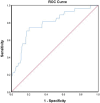Segmental bronchi radiation dose affected the progression of radiation pneumonitis in lung cancer patients
- PMID: 40380076
- PMCID: PMC12084462
- DOI: 10.1007/s12672-025-02569-1
Segmental bronchi radiation dose affected the progression of radiation pneumonitis in lung cancer patients
Abstract
Objective: To evaluate the association between the segmental bronchi radiation dose and radiation pneumonitis (RP) in patients with lung cancer who underwent radiotherapy.
Methods: A total of 135 patients with lung cancer who were treated with radiation therapy between December 2014 and December 2015 were enrolled in the study. RP was defined and graded according to the criteria of the Radiation Therapy Oncology Group. The radiation dose to the segmental bronchi, along with clinical, and other dosimetric factors were recorded. Logistic regression analysis was used to evaluate the association between the related factors and RP.
Results: Among the 135 enrolled patients, 24 (17.8%) developed grade 3 radiation pneumonitis or higher. Study found that RP was associated with the following factors: patient age, complications with chronic obstructive pulmonary disease, concurrent chemotherapy, percentage of lung volume receiving more than 30 Gy (V30), whole lung volume, and the segmental bronchi maximum and mean dose. Logistic regression analysis showed that the maximum dose of the segmental bronchi, whole lung volume, and V30 were independent risk factors for RP. According to the receiver operating characteristic curve, the maximum dose constraint of the segmental bronchi during radiotherapy is estimated at 23.85 Gy.
Conclusion: The segmental bronchi radiation dose should be considered as a normal tissue constraint, in addition to whole lung volume and V30 in radiotherapy for patients with lung cancer to decrease the incidence of RP.
Keywords: Lung cancer; Radiation; Radiation pneumonitis; Risk factor; Segmental bronchi.
© 2025. The Author(s).
Conflict of interest statement
Declarations. Ethics approval and consent to participate: The research was ethically approved by the Ethics Committee of the Hubei Cancer Hospital. Prior to participation, all participants were duly informed of their rights and responsibilities and provided explicit written consent. The study was conducted in agreement with the guidelines governing research involving human participants, as outlined by the Ethics Committee of the Hubei Cancer Hospital. Competing interests: The authors declare no competing interests.
Figures


Similar articles
-
Prediction of radiation pneumonitis: dose-volume histogram analysis in 62 patients with non-small cell lung cancer after three-dimensional conformal radiotherapy.Neoplasma. 2005;52(1):56-62. Neoplasma. 2005. PMID: 15739028 Clinical Trial.
-
Dose-volumetric parameters for predicting severe radiation pneumonitis after three-dimensional conformal radiation therapy for lung cancer.Radiology. 2005 Apr;235(1):208-15. doi: 10.1148/radiol.2351040248. Epub 2005 Feb 9. Radiology. 2005. PMID: 15703313
-
Exclusion of emphysematous lung from dose-volume estimates of risk improves prediction of radiation pneumonitis.Radiat Oncol. 2017 Oct 2;12(1):160. doi: 10.1186/s13014-017-0891-z. Radiat Oncol. 2017. PMID: 28969651 Free PMC article.
-
Dose-Volume Constraints Parameters for Lung Tissue in Thoracic Radiotherapy Following Immune Checkpoint Inhibitor Treatment.J Inflamm Res. 2024 Oct 9;17:7141-7154. doi: 10.2147/JIR.S484489. eCollection 2024. J Inflamm Res. 2024. PMID: 39398227 Free PMC article.
-
A prospective study on radiation pneumonitis following conformal radiation therapy in non-small-cell lung cancer: clinical and dosimetric factors analysis.Radiother Oncol. 2004 May;71(2):175-81. doi: 10.1016/j.radonc.2004.02.005. Radiother Oncol. 2004. PMID: 15110451
References
-
- Zeng H, Ran X, An L, Zheng R, Zhang S, Ji J, Zhang Y, Chen W, Wei W, He J. Disparities in stage at diagnosis for five common cancers in China: a multicentre, hospital-based, observational study. Lancet Public Health. 2021;6(12):e877–87. - PubMed
-
- Siegel RL, Miller KD, Wagle NS, Jemal A. Cancer statistics, 2023. CA Cancer J Clin. 2023;73(1):17–48. - PubMed
-
- Eberhardt WE, De Ruysscher D, Weder W, Le Péchoux C, De Leyn P, Hoffmann H, Westeel V, Stahel R, Felip E, Peters S, et al. 2nd ESMO Consensus Conference in Lung Cancer: locally advanced stage III non-small-cell lung cancer. Ann Oncol. 2015;26(8):1573–88. - PubMed
-
- Miller KD, Nogueira L, Mariotto AB, Rowland JH, Yabroff KR, Alfano CM, Jemal A, Kramer JL, Siegel RL. Cancer treatment and survivorship statistics, 2019. CA A Cancer J Clin. 2019;69(5):363–85. - PubMed
-
- Rose J, Rodrigues G, Yaremko B, Lock M, D’Souza D. Systematic review of dose-volume parameters in the prediction of esophagitis in thoracic radiotherapy. Radiother Oncol. 2009;91(3):282–7. - PubMed
LinkOut - more resources
Full Text Sources
